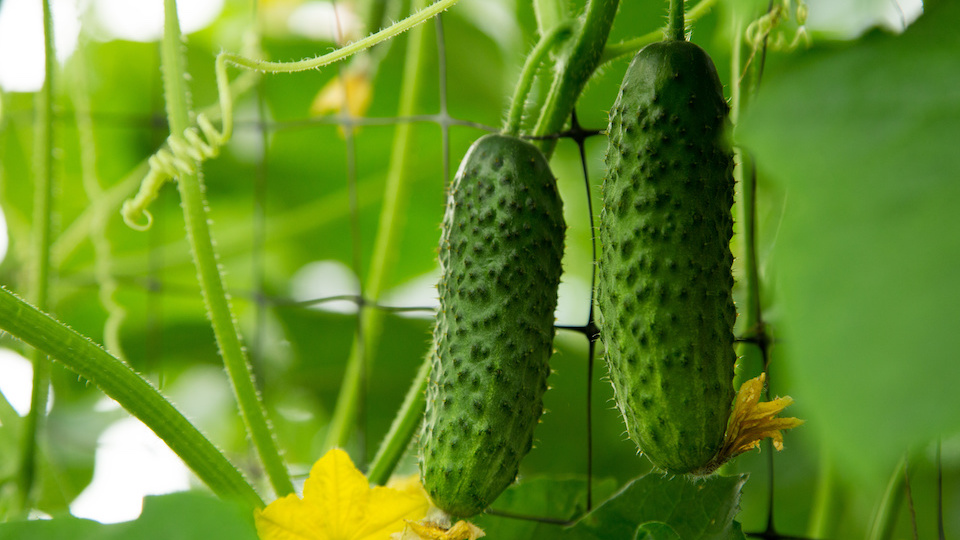There is nothing quite so delicious as homegrown cucumbers. I love them right off the vine. Like tomatoes, cucumbers are summer vegetables that thrive in warm weather. There are lots of tricks for getting a seriously huge harvest of healthy and delicious cucumbers in your garden this season.
There are two types of cucumber plants: vining cucumbers and bush cucumbers. Most types grow on strong vines that are shaded with big leaves. Bush types are perfect for small gardens and containers and can be planted every two weeks for continual harvest all season long. The best variety for easy pickling is the heirloom ‘Boston Pickling’ variety. All cucumbers grow fast, and if you care for them properly, you can have an abundant yield.
Starting and transplanting cucumbers
To get a head start on the cucumber growing season, start seeds indoors about three weeks before transplanting. Use a grow mat set at a bottom heat of 70 degrees F. If you do not have a heat mat, you can put your seed tray on top of your refrigerator or hot water heater. The best transplant time is two weeks after your last frost date. The soil needs to be at least 70 degrees F for germination. Be very cautious of the correct planting time because cucumbers are very susceptible to frost.
Choosing and preparing the planting site
The most important thing about your planting site is that it receives full sunlight. Cucumbers thrive when planted in a warm and sunny location. The soil must also be fertile, so mix in some aged manure to a depth of 2 inches and work into the soil 6 to 8 inches deep. The soil should be neutral in acidity or even slightly alkaline with a pH of around 7.0. It needs to be moist and well-draining and not compacted. If your soil is heavy and dense, add some peat moss to make it lighter.
Planting cucumbers
Plant seeds 1 inch deep and 2-3 feet apart, depending on the variety. If using a trellis, space plants about 1 foot apart. I like to plant cucumbers in hills that are spaced about 1 to 2 feet apart. When using this method, put 2-3 seeds in each mound. Once plants are about 4 inches tall, thin them down to one plant per mound.
After planting, mulch the area with straw, chopped leaves, or other organic mulch to help keep pests away and the soil warm and moist. Also, keep in mind that a trellis is an excellent idea to protect the fruit from lying on the ground and becoming damaged. If you have a lot of pests, consider covering your seeds with netting or a berry basket.
Watering cucumber plants
Once planted, cucumbers don’t require a whole lot of added attention. Make sure that you do water consistently. Plants need at least one inch of water per week. Consider more water if you live in a hot and dry climate. To see if water is required, push your finger down into the soil. When you get past the first joint on your finger, and the soil feels dry, it is time to water. Consistent water produces the best-tasting fruit. Another great watering tip has to do with when and how you water. The best time to water plants is in the morning before the sun gets too hot or in the very early afternoon. Be careful when you water to avoid the leaves. If moisture drops onto the leaves, it can encourage leaf disease, which can ruin an entire plant. The absolute best way to water cucumbers is by using a soaker hose or drip irrigation. Remember, sure to mulch to keep in soil moisture. When seedlings pop up, water frequently, and increase to one gallon per week after the fruit begins to form.
Harvesting cucumbers
One very important recommendation is not to let cucumbers get too large, or they won’t taste very good. Pick cucumbers every two days because they grow quickly. Harvest regular slicing varieties when they are about 6 to 8 inches long. Harvest dills when they are 5 to 6 inches long. Harvest pickling cucumbers when they are at least 2 inches long.
It is best to pick cucumbers before their seeds become too hard. This is usually when they are uniformly green and crisp. Tough skins will develop when cucs are left on the vine too long. Use a clean and sharp knife or clippers to cut the stem above the fruit. Don’t pull the fruit off because this may damage the vine. Keep picking; if you don’t, the plants will stop producing.
Special tips for success
- Spray vines with sugar water to attract bees and encourage fruit set.
- Use an organic liquid fertilizer that is low nitrogen and high potassium and phosphorus or a compost tea. Feed plants one week after they bloom and every three weeks after this, applying feed directly to the soil around the plants. If you use granular fertilizer, work this into the soil. Be careful not to over-fertilize, or the fruit will get stunted.
- When seedlings reach 4 inches tall, thin them so that they are 1 ½ feet apart.
- Side dress plants with organic matter like well-rotted manure.
- If using trellises, set them up early to avoid damage to plants.
- If you plant in containers, remember that these plants need to be watered more frequently than plants in the ground.
Happy planting!
-Susan Patterson




